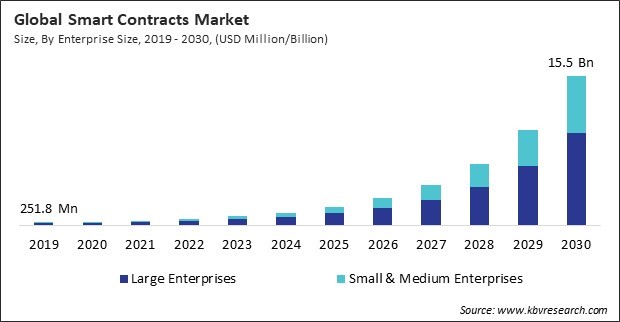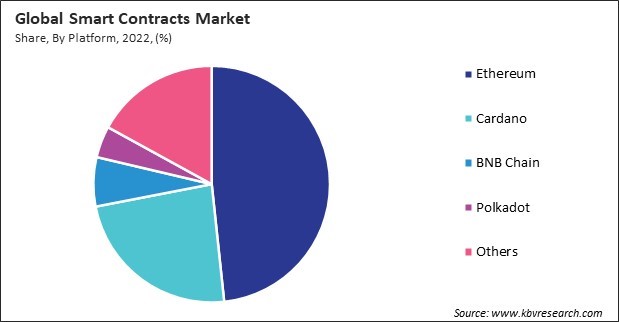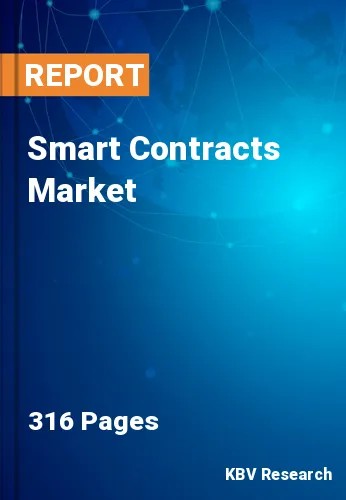“Global Smart Contracts Market to reach a market value of USD 15.5 Billion by 2030 growing at a CAGR of 50%”
The Global Smart Contracts Market size is expected to reach $15.5 billion by 2030, rising at a market growth of 50% CAGR during the forecast period.
Security and transparency are critical in real estate transactions. Smart contracts, built on blockchain technology, offer tamper-resistant and transparent record-keeping. Consequently, the real estate segment would generate approximately 13.08% share of the market by 2030. By giving property transactions and ownership documents an unchangeable and provable history of ownership, the blockchain lowers the possibility of fraud and disputes. As a result, there will be a rise in demand in the segment.

Smart contracts are agreements in which the provisions are written directly into code and are capable of self-execution. A decentralized and distributed ledger known as a blockchain records transactions across a network of computers. These contracts are executed on a blockchain. The foundational framework for the secure and transparent implementation of smart contracts is blockchain. Thus, these aspects will help expand the market. Moreover, Traditional contracts often involve intermediaries, such as banks, legal entities, or notaries, to validate and enforce agreements. Smart contracts operate on a decentralized blockchain, enabling direct peer-to-peer interactions without intermediaries. This not only speeds up processes but also reduces associated costs. Smart contracts automatically execute predefined terms when specific conditions are met. These factors will pose lucrative growth prospects for the market.
However, Immutability means that its code cannot be altered once a smart contract is deployed. If there are bugs or security vulnerabilities in the code, correcting them becomes a challenging task. This inflexibility may expose the smart contract to potential exploits, leading to financial losses or disruptions. Smart contracts are typically written by humans, and errors in the code can occur during the development phase. Thus, the smart contracts market will witness decreased demand in the coming years.
Based on enterprise size, the market is divided into large enterprises and small & medium enterprises. The large enterprises segment recorded the maximum revenue share in the market in 2022. Large enterprises often have intricate and multifaceted business processes that involve numerous stakeholders, departments, and regulatory considerations. Large businesses looking to improve efficiency in intricate workflows find smart contracts particularly appealing due to their capacity to automate and streamline procedures. These organizations can leverage smart contracts to optimize supply chain management, procurement, compliance, and other intricate processes. These factors will boost the demand in the segment.
On the basis of blockchain type, the market is divided into public, private, and hybrid. In 2022, the hybrid segment witnessed a substantial revenue share in the market. The hybrid approach is often adopted to address limitations of on-chain smart contracts, such as scalability and privacy concerns. By combining on-chain execution with off-chain processing, hybrid smart contracts aim to balance the transparency and security of on-chain operations and the scalability and efficiency of off-chain components. As a result, these aspects will pose lucrative growth prospects for the segment.
Based on platform, the market is segmented into Ethereum, Cardano, BNB chain, Polkadot, and others. The Ethereum segment held the largest revenue share in the market in 2022. Ethereum is widely recognized as the pioneer in blockchain platforms for smart contracts. Because of its strong and secure architecture, developers and businesses wishing to implement smart contracts and decentralized apps use it. Ethereum has played a central role in the explosive growth of decentralized finance (DeFi) applications. These factors will boost the demand in the segment.

By type, the market is segmented into decentralized autonomous organizations (DAO), application logic contracts, and smart legal contracts. In 2022, the application logic contracts segment acquired a considerable revenue share in the market. As more decentralized applications are being developed, the demand for smart contracts that govern their logic is increasing. Developers are creating contracts that handle various functionalities, such as token transfers, governance mechanisms, and complex business processes. Owing to these factors, there will be enhanced growth in the segment.
On the basis of end-use, the market is segmented into BFSI, logistics, healthcare, retail, real estate, and others. The BFSI segment recorded the maximum revenue share in the market in 2022. The BFSI industry has shown interest in leveraging smart contracts for lending and borrowing activities. Smart contracts can facilitate the creation and execution of programmable lending agreements, including terms, interest rates, and repayment schedules. Decentralized finance (DeFi) platforms, which often utilize smart contracts, have gained popularity for offering lending and borrowing services without traditional intermediaries. These aspects will pose lucrative growth prospects for the segment.
Free Valuable Insights: Global Smart Contracts Market size to reach USD 15.5 Billion by 2030
By region, the market is segmented into North America, Europe, Asia Pacific, and LAMEA. In 2022, the Asia Pacific segment acquired a considerable revenue share in the market. With nations like China, Japan, South Korea, and Singapore spearheading digital transformation projects, the Asia Pacific area has been at the forefront of the rapid adoption of new technologies. This eagerness to embrace new technologies has contributed to the increased adoption of smart contracts as businesses seek more efficient and secure transactions. These factors will boost the demand in the segment.
| Report Attribute | Details |
|---|---|
| Market size value in 2022 | USD 644.5 Million |
| Market size forecast in 2030 | USD 15.5 Billion |
| Base Year | 2022 |
| Historical Period | 2019 to 2021 |
| Forecast Period | 2023 to 2030 |
| Revenue Growth Rate | CAGR of 50% from 2023 to 2030 |
| Number of Pages | 316 |
| Number of Tables | 570 |
| Report coverage | Market Trends, Revenue Estimation and Forecast, Segmentation Analysis, Regional and Country Breakdown, Porter’s 5 Forces Analysis, Company Profiling, Companies Strategic Developments, SWOT Analysis, Winning Imperatives |
| Segments covered | Type, Platform, Blockchain Type, Enterprise Size, End-use, Region |
| Country scope |
|
| Companies Included | ScienceSoft USA Corporation, Innowise Sp. Z o.o, 4soft, Algorand Foundation Ltd., IBM Corporation, TATA Consultancy Services Limited, Oracle Corporation, Infosys Limited, Amazon.com, Inc., Coinbase Global, Inc. |
By Enterprise Size
By Blockchain Type
By Platform
By Type
By End-Use
By Geography
The Market size is projected to reach USD $15.5 billion by 2030.
Cost efficiency and automation trends are driving the Market in coming years, however, Oracles and external data dependency restraints the growth of the Market.
ScienceSoft USA Corporation, Innowise Sp. Z o.o, 4soft, Algorand Foundation Ltd., IBM Corporation, TATA Consultancy Services Limited, Oracle Corporation, Infosys Limited, Amazon.com, Inc., Coinbase Global, Inc.
The expected CAGR of this Market is 50% from 2023 to 2030.
The Decentralized Autonomous Organizations (DAO) segment is leading the Global Market by Type in 2022 thereby, achieving a market value of $5.8 Billion by 2030.
The North America region dominated the Global Market by Region in 2022 thereby, achieving a market value of $5 Billion by 2030, growing at a CAGR of 49.2 % during the forecast period.
Our team of dedicated experts can provide you with attractive expansion opportunities for your business.

 Drivers
Drivers
 Restraints
Restraints
